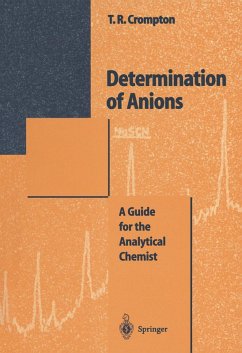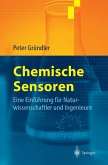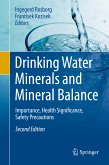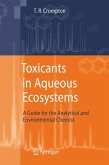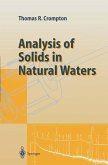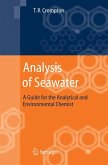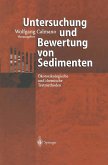233,95 €
233,95 €
inkl. MwSt.
Sofort per Download lieferbar

117 °P sammeln
233,95 €
Als Download kaufen

233,95 €
inkl. MwSt.
Sofort per Download lieferbar

117 °P sammeln
Jetzt verschenken
Alle Infos zum eBook verschenken
233,95 €
inkl. MwSt.
Sofort per Download lieferbar
Alle Infos zum eBook verschenken

117 °P sammeln
- Format: PDF
- Merkliste
- Auf die Merkliste
- Bewerten Bewerten
- Teilen
- Produkt teilen
- Produkterinnerung
- Produkterinnerung

Bitte loggen Sie sich zunächst in Ihr Kundenkonto ein oder registrieren Sie sich bei
bücher.de, um das eBook-Abo tolino select nutzen zu können.
Hier können Sie sich einloggen
Hier können Sie sich einloggen
Sie sind bereits eingeloggt. Klicken Sie auf 2. tolino select Abo, um fortzufahren.

Bitte loggen Sie sich zunächst in Ihr Kundenkonto ein oder registrieren Sie sich bei bücher.de, um das eBook-Abo tolino select nutzen zu können.
The author has drawn together almost all published methods since 1975 on the determination of anions in all types of matrices. He presents the methods in a logical manner so that the reader can quickly gain access to the method and types of instrumentation available.
- Geräte: PC
- ohne Kopierschutz
- eBook Hilfe
- Größe: 48.12MB
Andere Kunden interessierten sich auch für
- -60%11
![Chemische Sensoren (eBook, PDF) Chemische Sensoren (eBook, PDF)]() Peter GründlerChemische Sensoren (eBook, PDF)24,27 €
Peter GründlerChemische Sensoren (eBook, PDF)24,27 € ![Drinking Water Minerals and Mineral Balance (eBook, PDF) Drinking Water Minerals and Mineral Balance (eBook, PDF)]() Drinking Water Minerals and Mineral Balance (eBook, PDF)121,95 €
Drinking Water Minerals and Mineral Balance (eBook, PDF)121,95 €![Toxicants in Aqueous Ecosystems (eBook, PDF) Toxicants in Aqueous Ecosystems (eBook, PDF)]() T. R. CromptonToxicants in Aqueous Ecosystems (eBook, PDF)113,95 €
T. R. CromptonToxicants in Aqueous Ecosystems (eBook, PDF)113,95 €![Toxicants in Terrestrial Ecosystems (eBook, PDF) Toxicants in Terrestrial Ecosystems (eBook, PDF)]() T. R. CromptonToxicants in Terrestrial Ecosystems (eBook, PDF)73,95 €
T. R. CromptonToxicants in Terrestrial Ecosystems (eBook, PDF)73,95 €![Analysis of Solids in Natural Waters (eBook, PDF) Analysis of Solids in Natural Waters (eBook, PDF)]() Thomas R. CromptonAnalysis of Solids in Natural Waters (eBook, PDF)73,95 €
Thomas R. CromptonAnalysis of Solids in Natural Waters (eBook, PDF)73,95 €![Analysis of Seawater (eBook, PDF) Analysis of Seawater (eBook, PDF)]() T. R. CromptonAnalysis of Seawater (eBook, PDF)233,95 €
T. R. CromptonAnalysis of Seawater (eBook, PDF)233,95 €- -28%11
![Untersuchung und Bewertung von Sedimenten (eBook, PDF) Untersuchung und Bewertung von Sedimenten (eBook, PDF)]() Untersuchung und Bewertung von Sedimenten (eBook, PDF)89,99 €
Untersuchung und Bewertung von Sedimenten (eBook, PDF)89,99 € -
-
-
The author has drawn together almost all published methods since 1975 on the determination of anions in all types of matrices. He presents the methods in a logical manner so that the reader can quickly gain access to the method and types of instrumentation available.
Dieser Download kann aus rechtlichen Gründen nur mit Rechnungsadresse in A, B, BG, CY, CZ, D, DK, EW, E, FIN, F, GR, HR, H, IRL, I, LT, L, LR, M, NL, PL, P, R, S, SLO, SK ausgeliefert werden.
Produktdetails
- Produktdetails
- Verlag: Springer Berlin Heidelberg
- Seitenzahl: 583
- Erscheinungstermin: 6. Dezember 2012
- Englisch
- ISBN-13: 9783642614194
- Artikelnr.: 53091828
- Verlag: Springer Berlin Heidelberg
- Seitenzahl: 583
- Erscheinungstermin: 6. Dezember 2012
- Englisch
- ISBN-13: 9783642614194
- Artikelnr.: 53091828
- Herstellerkennzeichnung Die Herstellerinformationen sind derzeit nicht verfügbar.
1 Introduction.- 1.1 Rationale: Water Samples.- 1.2 Rationale: Solid and Gaseous Samples.- 1.3 Brief Summary of Methodologies.- 1.4 References.- 2 Halogen-Containing Anions.- 2.1 Chloride.- 2.2 Bromide.- 2.3 Iodide.- 2.4 Fluoride.- 2.5 Mixed Halides.- 2.6 Chlorate, Chlorite, Perchlorate and Hypochlorite.- 2.7 Bromate.- 2.8 Iodate.- 2.9 References.- 3 Nitrogen-Containing Anions.- 3.1 Nitrate.- 3.2 Nitrite.- 3.3 Nitrate and Nitrite.- 3.4 Free Cyanide.- 3.5 Total Cyanide.- 3.6 Cyanate.- 3.7 References.- 4 Sulphur Containing Anions.- 4.1 Sulphate.- 4.2 Sulphite.- 4.3 Thiosulphate and Polythionates.- 4.4 Thiocyanate.- 4.5 Sulphide.- 4.6 Polysulphide.- 4.7 References.- 5 Phosphorus Containing Anions.- 5.1 Phosphate.- 5.2 Condensed Phosphates.- 5.3 References.- 6 Silicon-Containing Anions.- 6.1 Silicate.- 6.2 References.- 7 Boron-Containing Anions.- 7.1 Borate.- 7.2 References.- 8 Carbonate, Bicarbonate and Total Alkalinity.- 8.1 Total Alkalinity.- 8.2 Carbonate.- 8.3 Bicarbonate.- 8.4 References.- 9 Metal-Containing Anions.- 9.1 Arsenite.- 9.2 Arsenate.- 9.3 Arsenite/Arsenate.- 9.4 Selenite.- 9.5 Selenate.- 9.6 Selenate/Selenite.- 9.7 Tellurate.- 9.8 Chromate/Dichromate.- 9.9 Germanate.- 9.10 Molybdate.- 9.11 Tungstate.- 9.12 Uranate.- 9.13 Vanadate.- 9.14 Titanate.- 9.15 Ferrocyanide.- 9.16 Metal Cyanide Complexes.- 9.17 References.- 10 Organic Anions.- 10.1 Formate and Acetate.- 10.2 Citrate.- 10.3 Isocitrate.- 10.4 Oxalate.- 10.5 Malate.- 10.6 Lactate.- 10.7 Salicylate.- 10.8 Ascorbate.- 10.9 Dehydroascorbate.- 10.10 Pyruvate.- 10.11 Glutamate.- 10.12 Amino Acids.- 10.13 Nitroloacetate and Ethylene Diamine Tetraacetates.- 10.14 Carboxylates.- 10.15 Sulphonates and Chlorolignosulphonates.- 10.16 Acetoacetate.- 10.17 Mixed Organic Anions.- 10.18 References.- 11 Applicationsof Ion Chromatography.- 11.1 Natural Waters.- 11.2 Rainwater.- 11.3 Potable Water.- 11.4 Industrial Effluents and Waste Waters.- 11.5 Boiler Feed Water.- 11.6 Plant and Soil Extracts.- 11.7 Foodstuffs.- 11.8 Column Coupling Isotachophoresis of Natural Waters.- 11.9 References.- 12 On-Site Measurement of Anions.- 13 On-Line Measurement of Anions.- 14 Preconcentration of Anions.- 14.1 Iodide.- 14.2 Phosphate.- 14.3 Sulphide.- 14.4 Borate.- 14.5 Arsenite.- 14.6 Selenate/Selenite.- 14.7 Chromate.- 14.8 Molybdate.- 14.9 Rhenate.- 14.10 Complex Anions.- 14.11 References.
1 Introduction.- 1.1 Rationale: Water Samples.- 1.2 Rationale: Solid and Gaseous Samples.- 1.3 Brief Summary of Methodologies.- 1.4 References.- 2 Halogen-Containing Anions.- 2.1 Chloride.- 2.2 Bromide.- 2.3 Iodide.- 2.4 Fluoride.- 2.5 Mixed Halides.- 2.6 Chlorate, Chlorite, Perchlorate and Hypochlorite.- 2.7 Bromate.- 2.8 Iodate.- 2.9 References.- 3 Nitrogen-Containing Anions.- 3.1 Nitrate.- 3.2 Nitrite.- 3.3 Nitrate and Nitrite.- 3.4 Free Cyanide.- 3.5 Total Cyanide.- 3.6 Cyanate.- 3.7 References.- 4 Sulphur Containing Anions.- 4.1 Sulphate.- 4.2 Sulphite.- 4.3 Thiosulphate and Polythionates.- 4.4 Thiocyanate.- 4.5 Sulphide.- 4.6 Polysulphide.- 4.7 References.- 5 Phosphorus Containing Anions.- 5.1 Phosphate.- 5.2 Condensed Phosphates.- 5.3 References.- 6 Silicon-Containing Anions.- 6.1 Silicate.- 6.2 References.- 7 Boron-Containing Anions.- 7.1 Borate.- 7.2 References.- 8 Carbonate, Bicarbonate and Total Alkalinity.- 8.1 Total Alkalinity.- 8.2 Carbonate.- 8.3 Bicarbonate.- 8.4 References.- 9 Metal-Containing Anions.- 9.1 Arsenite.- 9.2 Arsenate.- 9.3 Arsenite/Arsenate.- 9.4 Selenite.- 9.5 Selenate.- 9.6 Selenate/Selenite.- 9.7 Tellurate.- 9.8 Chromate/Dichromate.- 9.9 Germanate.- 9.10 Molybdate.- 9.11 Tungstate.- 9.12 Uranate.- 9.13 Vanadate.- 9.14 Titanate.- 9.15 Ferrocyanide.- 9.16 Metal Cyanide Complexes.- 9.17 References.- 10 Organic Anions.- 10.1 Formate and Acetate.- 10.2 Citrate.- 10.3 Isocitrate.- 10.4 Oxalate.- 10.5 Malate.- 10.6 Lactate.- 10.7 Salicylate.- 10.8 Ascorbate.- 10.9 Dehydroascorbate.- 10.10 Pyruvate.- 10.11 Glutamate.- 10.12 Amino Acids.- 10.13 Nitroloacetate and Ethylene Diamine Tetraacetates.- 10.14 Carboxylates.- 10.15 Sulphonates and Chlorolignosulphonates.- 10.16 Acetoacetate.- 10.17 Mixed Organic Anions.- 10.18 References.- 11 Applicationsof Ion Chromatography.- 11.1 Natural Waters.- 11.2 Rainwater.- 11.3 Potable Water.- 11.4 Industrial Effluents and Waste Waters.- 11.5 Boiler Feed Water.- 11.6 Plant and Soil Extracts.- 11.7 Foodstuffs.- 11.8 Column Coupling Isotachophoresis of Natural Waters.- 11.9 References.- 12 On-Site Measurement of Anions.- 13 On-Line Measurement of Anions.- 14 Preconcentration of Anions.- 14.1 Iodide.- 14.2 Phosphate.- 14.3 Sulphide.- 14.4 Borate.- 14.5 Arsenite.- 14.6 Selenate/Selenite.- 14.7 Chromate.- 14.8 Molybdate.- 14.9 Rhenate.- 14.10 Complex Anions.- 14.11 References.
